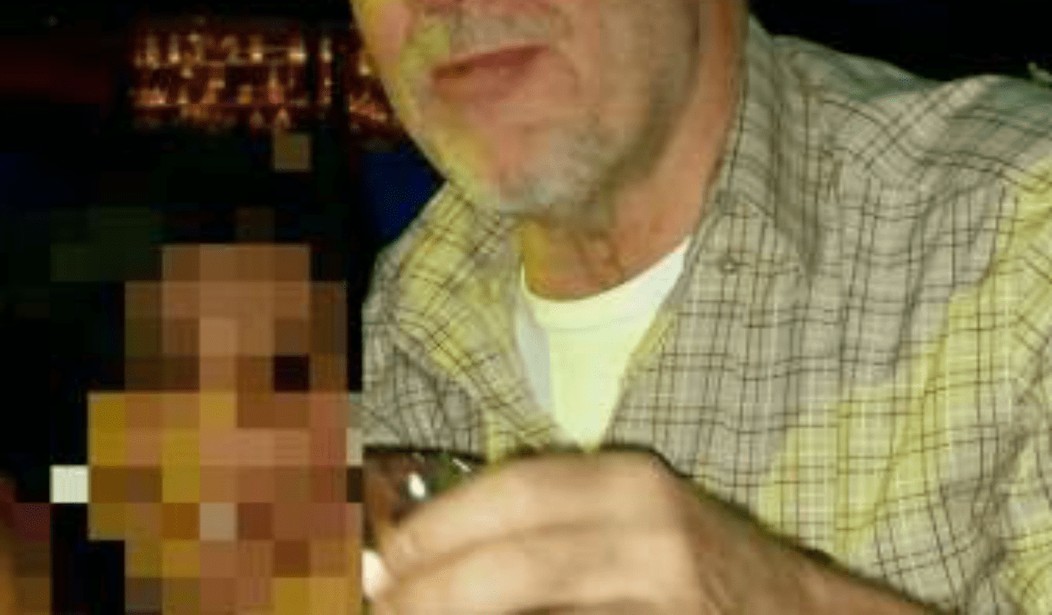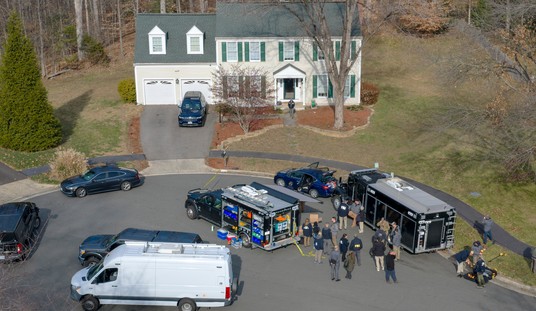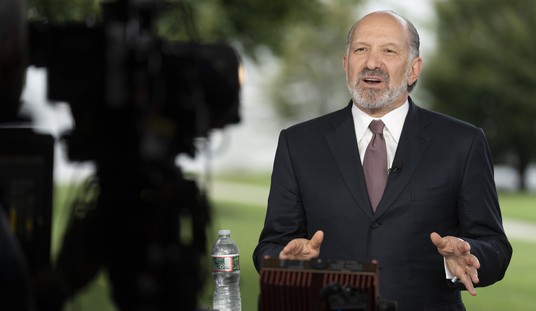On Sunday evening, a lone gunman terrorized Las Vegas, Nev., in what President Donald Trump called “an act of pure evil.” This became the deadliest mass shooting in U.S. history, but there have been many other such shootings.
Here is PJ Media’s list of the ten deadliest mass shootings.
10. Fort Hood, 13 killed.

The 2007 picture provided by the Uniformed Services University of the Health Sciences shows Nidal Malik Hasan when he entered the program for his Disaster and Military Psychiatry Fellowship. (Uniformed Services University of the Health Sciences)
On November 5, 2009, Maj. Nidal Malik Hasan killed 13 people and injured 32 others at Fort Hood, Texas. This was the worst mass shooting at an American military base.
Hasan was shot and paralyzed from the waist down during the shooting. He was arraigned by a military court on July 20, 2011, and charged with 13 counts of premeditated murder and 32 counts of attempted murder. His court-martial began on August 7, 2013. He was found guilty on August 23, 2013, and sentenced to death five days later.
A Joint Terrorism Task Force had been aware of emails between Hasan and Yemen-based imam Anwar al-Awlaki. The U.S. government refused to mark the shooting as an act of terrorism or motivated by radical Islamic terrorism, prompting a lawsuit from survivors.
While the Fort Hood shooting in 2009 was the tenth most deadly in U.S. history, there were 5 other mass shootings that killed 13 people. These include:
The Binghamton, New York, shooting of 13 people by Jiverly Wong on April 3, 2009.
The Columbine shooting in Littleton, Colo., in which 12 students and one teacher were murdered by 18-year-old Eric Harris and 17-year-old Dylan Klebold on April 20, 1999.
The Wah Mee shooting in Seattle, Wash., in which 13 occupants of the Wah Mee gambling and social club were killed on February 18, 1983. Kwan Fai Mak and Benjamin Ng are currently serving life in prison, while the third shooter, Wai-Chiu “Tony” Ng, was on the run in Canada but eventually deported to Hong Kong in 2014.
The Wilkes-Barre shooting, in which 40-year-old prison guard George Banks killed 13 people, including five of his own children, in Wilkes-Barre, Pa., on September 25, 1982.
The Camden shooting, in which 28-year-old Howard Unruh, a World War II veteran, shot and killed 13 people in Camden, N.J., on September 5, 1949. He was found insane and committed to a mental institution.
9. Edmond, Okla., 14 killed.
On August 20, 1986, part-time mail carrier Patrick Henry Sherrill killed 14 postal workers in 10 minutes and took his own life with a bullet to the head. He also wounded six other workers, who survived the shooting. He had served in the U.S. Marine Corps and was considered an expert marksman.Sherrill was often required to work alternate routes on different days, and he did not have the job stability of other U.S. Postal Service workers. On August 19, the day before the shooting, supervisors Richard Esser, Jr. and Bill Bland reprimanded Sherrill.
Sherrill’s attack inspired the phrase “going postal.”
8. San Bernardino, 14 killed.

This undated combination of photos provided by the FBI, left, and the California Department of Motor Vehicles shows Tashfeen Malik, left, and Syed Farook. (FBI, left, and California Department of Motor Vehicles via AP)
On December 2, 2015, married couple Syed Rizwan Farook and Tashfeen Malik attempted to bomb a Christmas party at the Inland Regional Center in San Bernardino, Calif., and started shooting attendees. The couple killed 14 people and seriously injured 22 others. Farook was a U.S.-born citizen of Pakistani descent, and Malik was a Pakistani-born U.S. resident.
The shooters were killed in a police shootout four hours after the attack. The FBI found that the perpetrators were “homegrown violent extremists” inspired by foreign terrorist groups, but not directed by such groups and not part of any terrorist cell.
The San Bernardino shooting was the deadliest terror attack on U.S. soil since the September 11 attacks, until last June’s shooting in Orlando, Fla.
7. University of Texas, 18 killed.

This 1966 file photo shows Charles J. Whitman, a 24-year-old student at the University of Texas, a sniper who killed 16 and wounded 31 from the tower of the University of Texas administration building in Austin, Texas, Aug. 1, 1966. Public domain.
On August 1, 1966, former U.S. Marine Charles Joseph Whitman killed 16 and wounded at least 30, shooting from a tower at the University of Texas in Austin. Police officers Ramiro Martinez and Houston McCoy shot and killed Whitman, even while the shooter remained in the tower.
Whitman had also killed his mother and his wife earlier that day. His shooting spree lasted 96 minutes. Before the attack, Whitman had sought professional help for “overwhelming violent impulses,” including fantasies about shooting people from the tower. An autopsy found a small brain tumor after his death.
At 12 years old, Whitman had become the youngest person to attain the rank of Eagle Scout.
6. San Ysirdro, 21 killed.
On July 18, 1984, 41-year-old James Huberty killed 21 people and injured 19 others at a McDonald’s in San Ysirdo, Calif. A SWAT team sniper took him down one hour after his murder spree began.
Three days before the shooting, Huberty told his wife, Etna, that he suspected he might have a mental problem. He actually called a mental health clinic the day before the shooting. He waited by the telephone for several hours awaiting a return call.
The next morning, Huberty took his wife and daughters to the San Diego Zoo. He told his wife his life was effectively over, and referred to the phone call to the mental health clinic as “society’s chance” to stop him.
After kissing his wife goodbye and telling her he was “going hunting humans,” he drove — first to the Big Bear supermarket, then to the U.S. Post Office, and later settling on the McDonald’s parking lot.
5. Luby’s Cafeteria, 23 killed.

A memorial for those killed in the Luby’s shooting in Killeen, Texas. By Larry D. Moore, CC BY-SA 3.0, https://commons.wikimedia.org/w/index.php?curid=27626929
On October 16, 1991, 35-year-old George Hennard killed 23 people and wounded 27 others after crashing his pickup truck through the wall of a Luby’s Cafeteria in Killeen, Texas. He committed suicide after the massacre.
Hennard was described as angry and withdrawn, with a hatred of women and ethnic minorities. Before opening fire, he reportedly yelled, “All women of Killeen and Belton are vipers! This is what you’ve done to me and my family! This is what Bell County did to me…. This is payback day!”
The restaurant was crowded for National Boss’s Day. Hennard was unemployed.
4. Sandy Hook, 27 killed.
On December 14, 2012, 20-year-old Adam Lanza killed 20 children and six adults at Sandy Hook Elementary School in Newtown, Conn. He had already killed his mother at home before the massacre. Lanza committed suicide as first responders arrived.
A November 2013 report from the Connecticut State Attorney’s office found that Lanza acted alone, but no evidence provided showed why he targeted the school. A November 2014 report from the Office of the Child Advocate found that Lanza had Asperger’s syndrome, and suffered from depression, anxiety, and obsessive-compulsive disorder as a teenager.
This shooting sparked renewed calls for gun control legislation, despite the fact Lanza stole the guns from his mother.
3. Virginia Tech, 32 killed.

The site of the Virginia Tech massacre. By Christopher – Norris Hall, CC BY-SA 2.0, https://commons.wikimedia.org/w/index.php?curid=1959639
On April 16, 2007, 23-year-old student Seung-Hui Cho killed 32 people and wounded 17 others in two separate attacks at Virginia Polytechnic Institute and State University in Blacksburg, Va. His two attacks occurred approximately two hours apart in two separate campus locations.
Before the shooting, Cho had been diagnosed with a severe anxiety disorder. He received therapy and special education help during middle school and high school.
Federal privacy laws prevented Virginia Tech from learning about Cho’s previous diagnosis. He was accused of stalking two female students in 2005, and he was later declared mentally ill. Because he was not institutionalized, he was still allowed to purchase guns.
President George W. Bush signed a law strengthening the National Instant Criminal Background Check System (NICS) in January, 2008.
2. Pulse nightclub, 49 killed.
On June 12, 2016, 29-year-old Omar Saddiqui Mateen killed 49 people and injured more than 50 others at the Pulse nightclub in Orlando, Fla. Police shot and killed Mateen after a three-hour standoff.
Shortly before the attack, Mateen called 911, swearing allegiance to Allah and to the Islamic State (ISIS) leader Abu Bakr al-Baghdadi. The Obama FBI doctored the transcript of the call, changing “Allah” to “God.”
While initial reports said Mateen may have been a patron of the Orlando nightclub, the FBI said they did not find any credible evidence to back that up. The CIA also reported finding no evidence of communications between ISIS and Mateen, even though the shooter pledge allegiance to ISIS and ISIS claimed responsibility for the attack.
CNN Anchor Sally Kohn used the Orlando shooting to attack Christians as “homophobic.” Even so, a local Chick-fil-A location fired up the grill on a Sunday (the day Chick-fil-A is usually closed), to serve free food to those giving blood to help the victims of the shooting.
1. Las Vegas, 58 killed.
https://www.facebook.com/Stephenpaddockupdates/photos/a.179370195944408.1073741825.179370155944412/179370315944396/?type=3
Sunday evening was the final night of the Route 91 Harvest Music Festival, headlined by singer Jason Aldean Williams.
Paddock’s motive remains unclear. “I can’t get into the mind of a psychopath,” Las Vegas Sheriff Joseph Lombardo said at a news conference Monday.
ISIS claimed responsibility for the shooting, but no evidence supporting this claim has yet emerged. Hillary Clinton launched an attack on the National Rifle Association (NRA) on Monday morning.













Join the conversation as a VIP Member